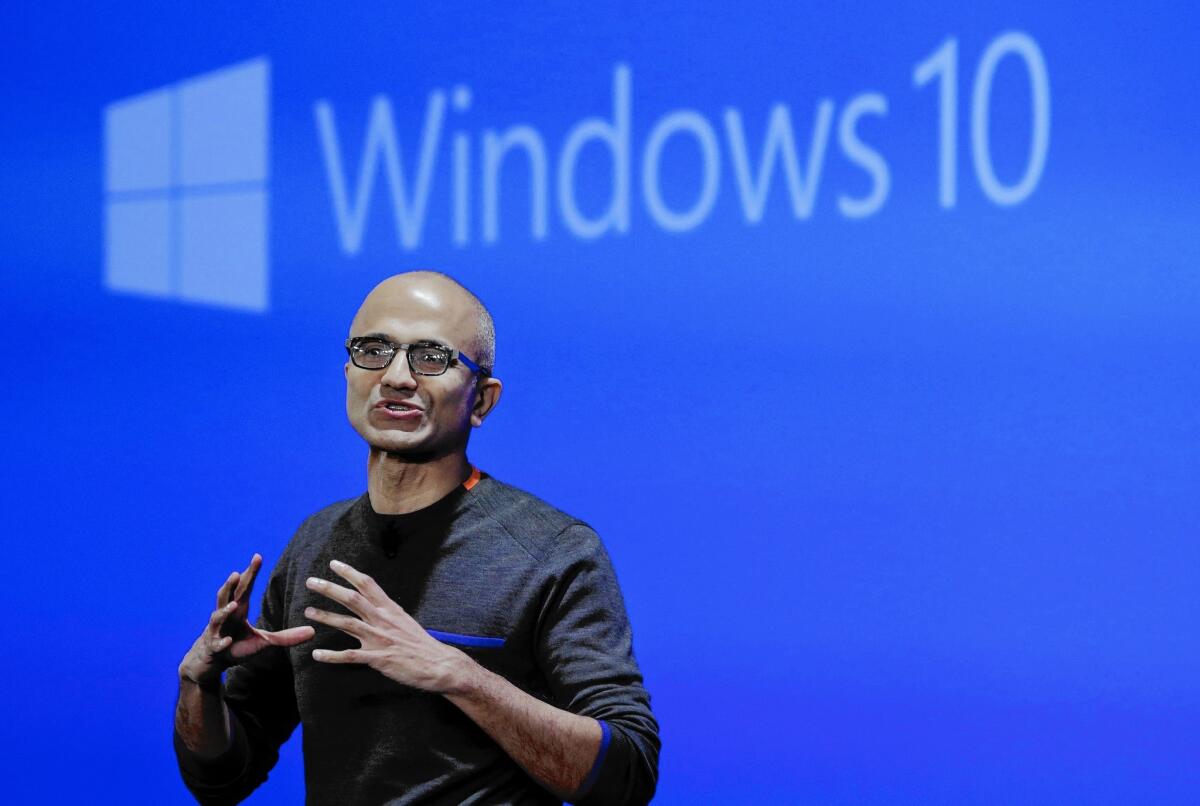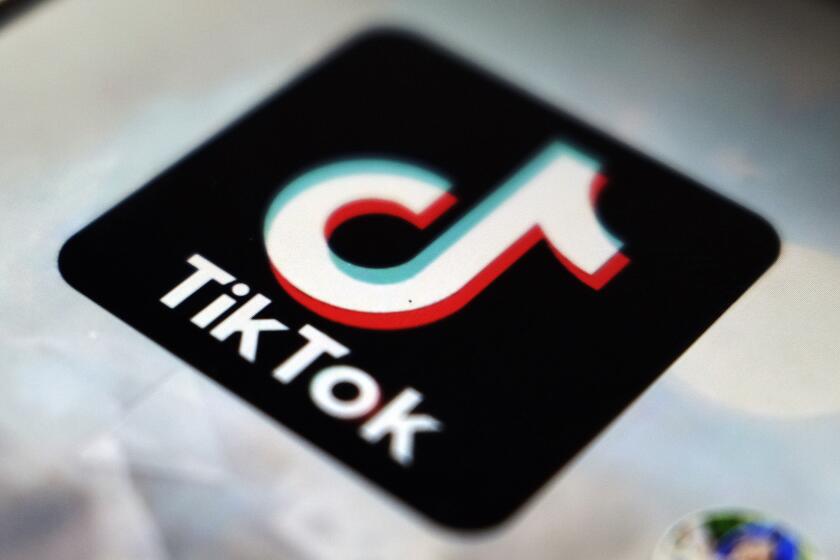Microsoft hopes computer users show some love for Windows 10

- Share via
Know someone required to use Microsoft Windows at work but who uses a Mac at home? Probably so.
As Apple has hopped from a global afterthought to the world’s fifth-largest computer maker, Microsoft’s Windows operating system has endured on its status as a must-have work tool, not something a user could love.
When Windows 10 goes on sale Wednesday, a new courtship begins. Microsoft Chief Executive Satya Nadella knows that if Microsoft is to compete with Apple, Google and others for another generation, Windows must become desired.
“We want to move from people needing Windows to choosing Windows, to loving Windows,” Nadella said.
The urgency is clear. Microsoft generates nearly one-fifth of its revenue from selling Windows to corporate information technology departments and computer manufacturers. As sales of desktops and laptops have fallen, Microsoft has suffered.
Last month, Microsoft closed its least profitable fiscal year in a decade. Annual operating income slacked 35% to about $18 billion.
Aside from the Xbox gaming device, Microsoft has misfired in attempts to keep pace in the mobile era. Its Surface tablets have only recently been marked a success, and its moves into smartphones crumpled into costly disaster. Microsoft recently wrote down nearly all of the more than $9 billion former Chief Executive Steve Ballmer paid less than two years ago for Nokia’s phone-making division, acknowledging that it was trying too hard to sell phones that hardly anyone wanted.
“Microsoft’s two biggest challenges: They are reliant on a PC market, and in mobile they are a rounding error in market share,” said Daniel Ives, senior analyst at FBR Capital Markets.
Nevertheless, Microsoft continues to carry tremendous influence. Windows 7 remains the most-used operating system on traditional PCs, and it’s a brand that corporate IT departments won’t abandon any time soon.
Now, “the stage is set for Windows 10 to lead them into their next phase of growth, but as you see less demand for PCs, Microsoft needs to figure out what their next magic trick is,” Ives said.
In his year-plus on the job, Nadella has generated ideas to turn around Microsoft — and diversify the way it makes money. There’s computerized eyewear, slick consumer apps and special tools for businesses under development. But Windows 10 is as crucial as anything Microsoft has done because Nadella needs the enormous cash flow the operating system generates to keep investors from losing confidence as he rebuilds.
Microsoft fixed the gripes that made most people and businesses skip Windows 8 three years ago. The last major Windows upgrade excessively catered to tablet users, relied on Microsoft’s online services and dismissed what turned out to be the beloved Start menu. Windows 8 suffered from an image problem; sales reflected that.
The Windows 10 upgrade preserves settings, such as background images, and can seamlessly sync them along with files and apps to other devices. Compatibility with older apps, printers and other mainstream peripherals hasn’t been an issue. On computers with touch-screen capability, it works well whether controlled by touch or mouse and keyboard.
Windows 10 also makes standard apps faster and more robust. It’s much easier, for instance, to connect a Gmail account with the Mail program. Personalization and alphabetization in the Start menu makes starting apps quicker. Cortana, Microsoft’s virtual assistant counter to Apple’s Siri, could be a huge timesaver for users hunting for files or just a fun source of entertainment.
Future improvements will be free and more frequent. They’ll have been run by 5 million testers to limit hiccups.
“There should be fewer surprises when it hits the wild,” said Steve Kleynhans, vice president at consulting firm Gartner Inc.
Some businesses have been so eager to switch to Windows 10, especially because of improved security features, that they’ve prepared for months. Michael Keithley, chief information officer for talent management company Creative Artists Agency, grew optimistic after his team’s testing.
Replacing log-in passwords with facial scans was among the new items that excited Keithley. He expects the thousands of computers at CAA should be running Windows 10 instead of Windows 7 by the end of the year.
SIGN UP for the free California Inc. business newsletter >>
“There’s a general belief that Microsoft under their new leadership has done a lot of positive things,” he said. “Everyone’s cautiously optimistic about Windows 10.”
One new feature tells users what companion Microsoft mobile apps they should download when a smartphone is connected.
Nadella has bought popular apps such as building game Minecraft and task manager Wunderlist. He’s boosted efforts to develop Microsoft Office for iPhones, iPads and Android devices. Cortana is coming to Android and iPhones as well.
Building apps for non-Microsoft products won’t just make life easier for Windows 10 users. Microsoft hopes they showcase Microsoft’s innovation and persuade consumers to give Windows a second look.
At the least, they could form the basis of a new Microsoft. To make up for some of the expected decline in Windows revenue, Microsoft is banking on such things as greater usage of the ad-supported Bing search engine and increased sales of its apps and games.
“We’re confident that these are the right levers to revitalize Windows and restore growth,” Nadella told analysts last week.
New computers with Windows 10 installed will start appearing Wednesday, but the best deals and products are expected to arrive closer to the holidays. Microsoft, for its part, isn’t expecting much revenue from Windows 10 this year. Some businesses say they won’t do mass upgrades, but rather buy Windows 10 machines as needed, further slowing sales.
For consumers with Windows 7 or 8, Windows 10 is a free upgrade for a year. Otherwise, it costs about $120.
Last week, the company launched a marketing campaign that reminds consumers Windows shouldn’t feel like a necessity. TV ads showcase babies smiling, crawling and playing, with a voice-over by actor Ethan Hawke subtly mentioning Windows 10 features.
“They’ll expect their devices to listen to them, and talk, and sing, and tell a funny joke,” he says of the babies in an allusion to Cortana, for instance.
The ads acknowledge Microsoft’s challenge: It’s time to foster love for Windows, but it might take a generation.
Twitter: @peard33
MORE BUSINESS NEWS:
China’s stock market drops 8.5%, its biggest single-day fall since 2007
Facing regulatory roadblocks, Uber ramps up its lobbying in California
A fee to be the first to exit a plane? Many fliers are willing to pay it
More to Read
Inside the business of entertainment
The Wide Shot brings you news, analysis and insights on everything from streaming wars to production — and what it all means for the future.
You may occasionally receive promotional content from the Los Angeles Times.











